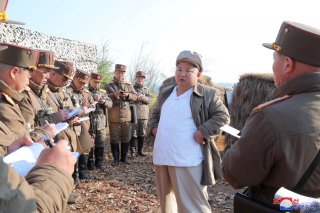There’s Little Reason to Fear North Korea’s Massive Ground Forces
Not even the Korean People’s Army’s numerical personnel superiority is without significant caveats.
Here's What You Need to Know: Pyongyang’s massive conventional defense outlays continue to yield negligible military value. They have succeeded only in propping up a bloated and increasingly unviable military-industrial complex that cannot be meaningfully reformed without a comprehensive decommission and modernization effort.
North Korea’s defense budget occupies a staggering 23% of its GDP, by far the highest proportion of any 21st-century country. The DPRK’s massive military outlays have gone, in no small part, towards sustaining the fourth-largest standing army in the world. There is little question that North Korea’s prodigious ground forces are, and will be, the backbone of its capacity to wage conventional war on the Korean Peninsula. In the years following the Korean War, the North’s Korea People’s Army (KPA) was markedly smaller, but better-equipped and exponentially more modernized than its southern counterpart. These roles have all but flipped in the decades of North Korean military stagnation and economic neglect that accompanied the collapse of its Soviet benefactor.
A closer look at North Korea’s current ground forces paints the picture of a bloated army, crippled by technical backwardness and severe logistical deficits.
Despite the regime’s insulated nature, the combined efforts of South Korean and U.S. intelligence have generated reliable and fairly consistent data concerning the KPA’s makeup. The DPRK’s army consists of 1.2-1.3 million active personnel with around 6 million more reservists, 6,000 tanks, up to 15,000 artillery pieces, 6,500 - 10,000 armored vehicles, just under 300 military helicopters, and 2,100 rocket launchers.
At first glance, these numbers would seem to put the KPA in the running for one of the world’s strongest armies; in most categories, the DPRK boasts roughly twice the units of South Korea’s armed forces. But the KPA’s sheer numbers belie an altogether different reality: the bulk of KPA equipment is grossly outdated, with a great swathe being borderline inoperable.
For instance, the KPA’s tank force is largely made up of Soviet T-54/55, T-62, and domestic T-62 variants that are more befitting of a military museum than a contemporary battlefield. It remains unclear how many of these antique models, some of which are over seven decades old, are in active service. Even assuming that many or even most of them are in an operable state, the KPA’s tanks are of dubious battlefield value when compared with the much newer and significantly more powerful K-1 and K-2 series tanks fielded by the ROK’s armed forces.
The same dynamic is evident in the KPA’s artillery roster. North Korea’s M-30 and D-20 are mid-20th century Soviet howitzers being held back by their low range and cripplingly poor accuracy. The 170-millimeter Koksan, the KPA’s largest artillery piece, suffers from an abnormally high dud rate and is unlikely to inflict meaningful damage on critical South Korean infrastructure or military equipment before being neutralized by ROK counter-battery fires.
Elsewhere, as with armored combat vehicles and attack helicopters, the ROK occupies both qualitative and quantitative superiority. The KPA’s deficit in the latter is surprisingly stark, with the ROK army boasting downwards of 700 helicopters in active military service.
Not even the KPA’s numerical personnel superiority is without significant caveats. There are credible, well-sourced reports that large swathes of the KPA are plagued by basic equipment shortages, crippling malnourishment and, more recently, a lethal Covid-19 outbreak.
The KPA’s decrepit state follows a similarly grim pattern to that of North Korea’s moribund air force and obsolete parts of its navy. By widespread expert consensus, the DPRK stands to lose decisively in a contemporary conventional war with the ROK.
Pyongyang’s massive conventional defense outlays continue to yield negligible military value. They have succeeded only in propping up a bloated and increasingly unviable military-industrial complex that cannot be meaningfully reformed without a comprehensive decommission and modernization effort.
Mark Episkopos is a frequent contributor to The National Interest. Mark is also a PhD student in History at American University.
This article first appeared in September 2020.
Image: Reuters

